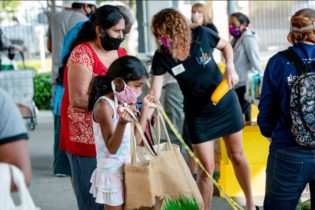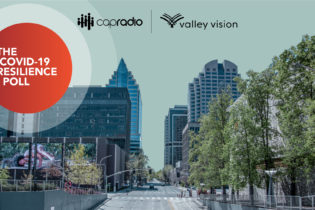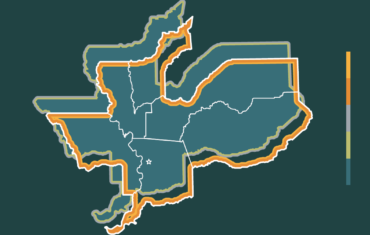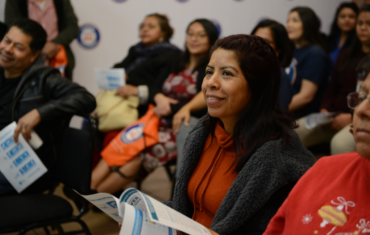COVID-19 Imposed Inequitable Hardships on People of Color and Younger Adults, Latest Public Opinion Poll Reveals
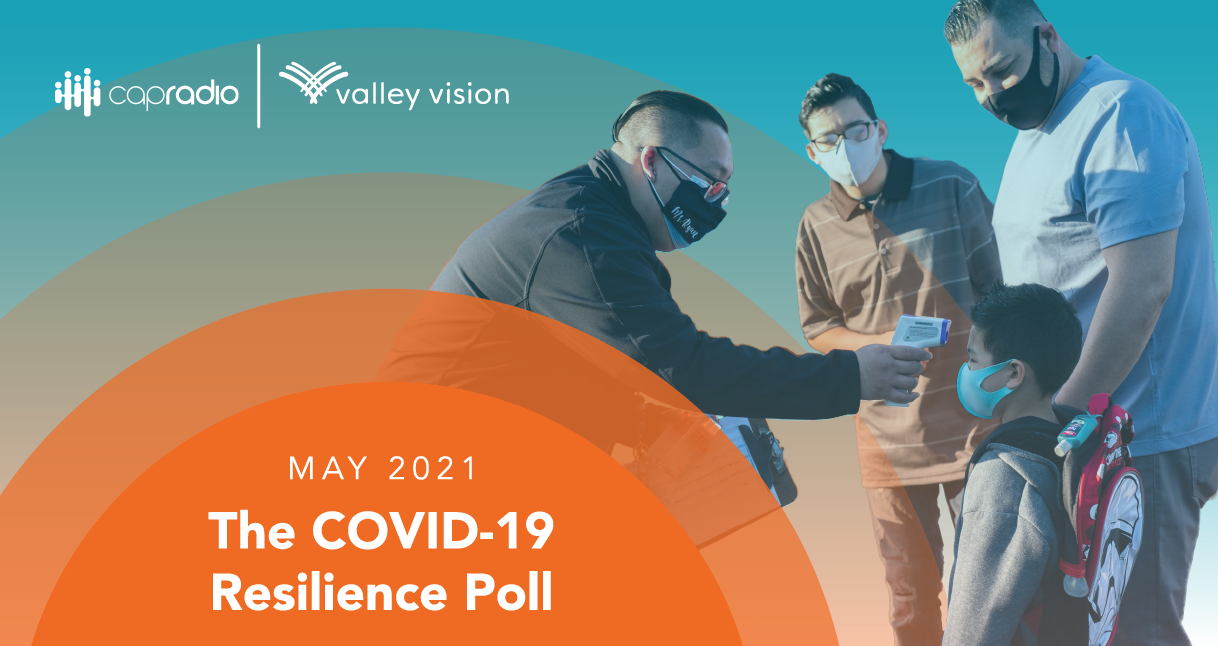
Sacramento, CA – May 10, 2021: Three public opinion polls fielded through a year of the COVID-19 pandemic from May 2020 to March 2021 revealed that the health crisis had a significant impact on the financial and emotional well-being for many. Communities of color, those earning less, and those who are younger, have been more severely impacted than others, experiencing greater income loss, more difficulty affording basic necessities, and deeper fears and concerns about financial security and mental health.
Valley Vision and CapRadio released today the third and final COVID-19 Resilience Poll, which was fielded by the Institute of Social Research (ISR) at Sacramento State between March 12-29, 2021. The research is demographically representative of the Capital region, encompassing Sacramento, El Dorado, Placer, Sutter, Yolo, and Yuba counties, with a margin of error of +/- three percent.
“The latest report highlights clear themes that emerged from polling over a year of the pandemic.” said Valley Vision CEO Evan Schmidt. “The impact is expected to be felt for years to come and will likely signify historic shifts in our social, political, and economic landscape. The findings point to the unique challenges our region now faces and where we most need to focus system change to build an equitable recovery.”
The research findings show the greatest hardships were felt by vulnerable communities. In the most recent poll, 41% of respondents overall reported a loss of income during the pandemic. For Black, Hispanic, and Asian/NHPI respondents, that number is much higher.
“The three surveys in the past year make it clear that vulnerable communities feel even more vulnerable because of the pandemic,” said Nick Miller, managing editor of news and information at CapRadio. “Our journalists will be looking deeply at these issues on CapRadio this week.”
These findings are consistent with what is taking place across the United States. A study conducted by the Pew Research Center in April 2020 found that 26% of middle-income adults and 53% of lower income adults could not pay their bills in full that month. Only 23% of lower income adults and 48% of middle-income adults reported having “rainy day funds” that would cover expenses for three months in case of an emergency, compared to 75% of higher income adults.
“In addition to the toll taken on lives, overall well-being, and jobs, one constant throughout the pandemic has been the rapid-response system transformation,” Schmidt said. “Valley Vision and CapRadio publicize these findings to help local leaders shape future social, civic, and economic structures to help make all of our communities inclusive, supported, safe, and equitable.”
TOP COVID-19 RESILIENCE POLL LEAD FINDINGS:
Financial hardship: Communities of color, those earning less, and those who are younger experienced greater income loss, more difficulty affording basic necessities, and deeper fears and concerns about financial security.
- 54 to 61%of those with significantly reduced income couldn’t afford an adequate food supply throughout the year.
- 59 to 68% said they couldn’t afford rent or mortgage.
- 39 to 47% of 18- to 39-year-olds said they couldn’t afford to pay down debt.
Workplace: The circumstances of the pandemic spurred a seemingly ten-year acceleration of new workplace trends toward remote work, automation, and e-commerce.
- The percent of people who work from home either part or full time shot up from 38% prior to the pandemic to 70% during the pandemic.
- 78% said they want to work at home at least one day a week; 28% said that they want to work at home full time.
- By larger margins, 18- to 38-year-olds believe the pandemic has made them less employable due to concerns over availability of jobs, changes in their industry, and their skillset.
Mental and Emotional: The pandemic created significant increases in depression, anxiety and stress, concerns about substance use, and concerns about physical and emotional violence at home.
- The likelihood of experiencing stress or anxiety, or depression or hopelessness decreased as income level increased.
- 92% of Hispanic respondents reported feelings of stress or anxiety at least one day in the last seven days, followed by 85% of Asian/NHPI respondents, and 82% of Black respondents.
- Respondents who are white were least likely to have experienced these feelings (52%).
Education: A year of educating from home has been difficult on parents, students and teachers, with more than two-thirds of parents reporting concerns about their children falling behind academically.
- In May 2021, 79% of those with children said they were doing some kind of remote learning.
- 54% of parents were more likely to have lost income, compared to 34% of non-parents.
- 71% of parents reported being concerned about their ability to handle other responsibilities.
- 69% of parents said having children in school partly or fully remotely was negatively affected their ability to do their job.
Beyond COVID-19: The last poll found that vaccination skepticism is likely to impact our region, with 39% of respondents stating that they would probably not or definitely not get a COVID-19 vaccination when it becomes available to them.
- Black respondents were significantly more skeptical than other race/ethnicities, with 65% reporting they probably or definitely would not get a vaccine, compared to 44% of white, 29% of Hispanic, and 15% of Asian/NHPI respondents.
- 71% of respondents reported knowing someone who had COVID-19.
###
About the Polling Series Valley Vision and CapRadio, in partnership with the Institute of Social Research (ISR) at Sacramento State, conduct research via scientifically administered surveys of area resident attitudes. The survey data inform policy-makers and stakeholders on key regional issues by providing on-the-ground public engagement data. The approach used is highly effective and unique by establishing a scientifically valid and demographically representative panel of regional residents that reflects a microcosm of the region as a whole. The panel size is consistently about 2,000 people from six counties – Sacramento, Yolo, El Dorado, Placer, Yuba, and Sutter. The panel is weighted to demographically represent the region and each survey achieves a statistical valid margin of error of not more than +/- 3%.
About Valley Vision For more than 25 years Valley Vision has used research to help governments, businesses, foundations and community groups better understand the issues facing our region. We believe that knowing and understanding the facts is the best way to establish a common working foundation for collaborative problem-solving. That’s why Valley Vision conducts, produces and interprets research including scientific public opinion polls, focus groups, community needs assessments, best practice studies and other research tools to bring to light the information local leaders need to improve our communities.
About Sacramento State’s Institute for Social Research ISR supports community partners in improving programs and policies in the region and throughout the state. Located at the university’s downtown location, the Institute offers a broad range of expertise conducting surveys and applied research. Since 1989, our collaborations with government agencies and nonprofit organizations have contributed to public accountability, program fidelity, and the strengthening of communities.
About CapRadio CapRadioserves California’s Capital Region, Central Valley and Sierra Nevada as the public-supported alternative to for-profit media. As the NPR-member station based in Sacramento, CapRadio connects with communities through seven broadcast stations, live streaming, podcasts, digital communities, live experiences and more. Known for its award-winning newsroom, CapRadio is recognized as a leader in community-engaged journalism and state government reporting, and CapRadio Music is the exclusive broadcast source of classical and jazz in the region. With more than 500,000 weekly listeners on-air and online, CapRadio provides a trusted and indispensable source of information, music and events.
